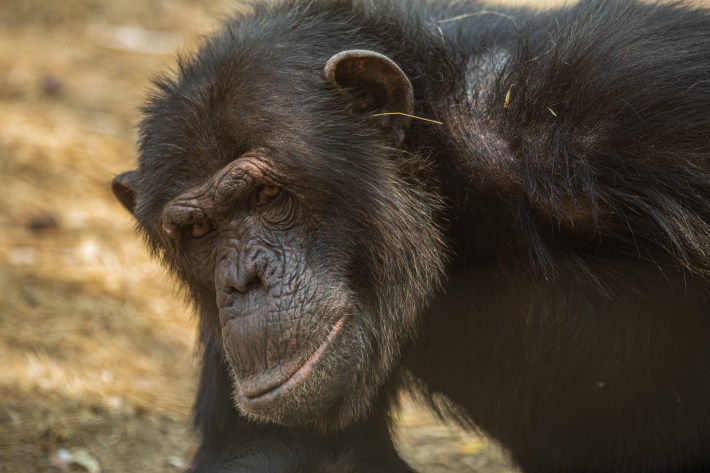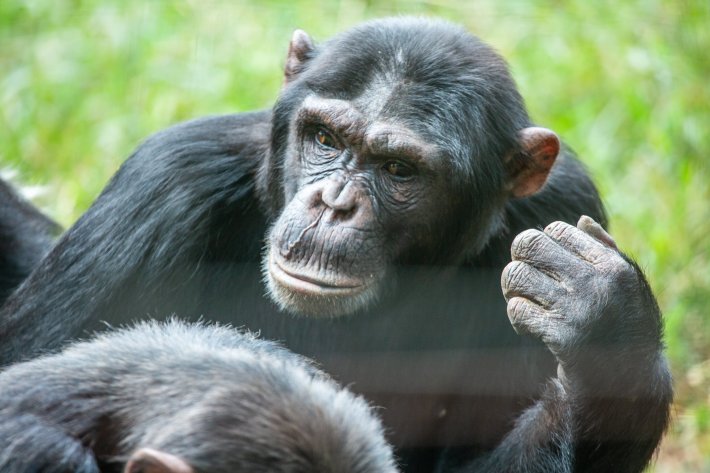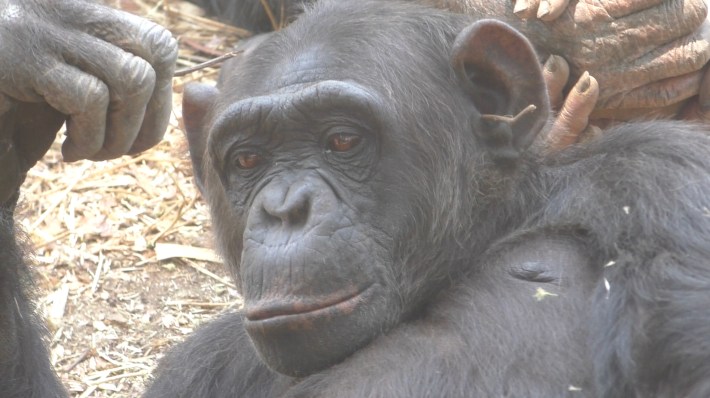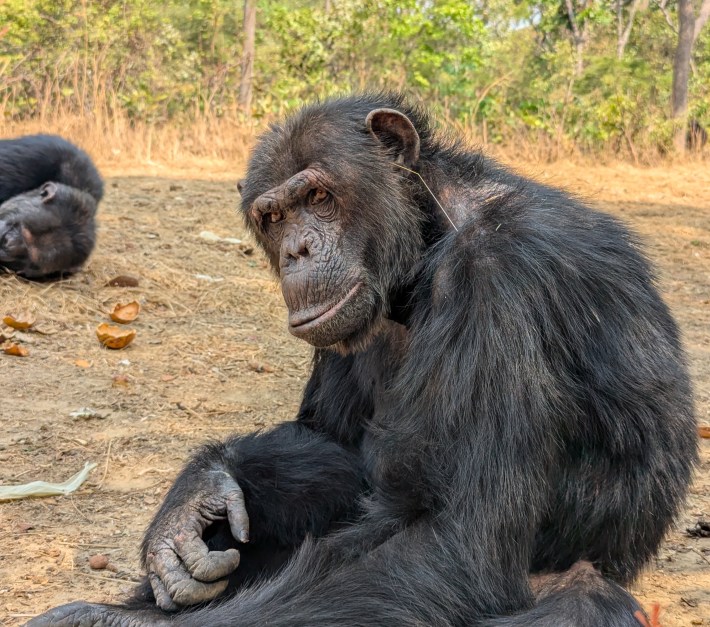Fifteen years ago in a sanctuary in Zambia, inspiration struck a chimpanzee named Julie. She plucked a stiff blade of grass, stuck it inside her ear, and left it there. There the grass dangled as Julie played, groomed, and rested. The behavior soon spread to most of the other chimpanzees in Julie’s group, called Group 4, and was adopted by her son Jack and chimps Kathy, Miracle, and Val. In the span of just one year, Julie was observed with grass in her ear 168 times; by comparison, the next most frequent observer was Kathy, with 36 grass-in-ear sightings. After Julie died in 2013, her invention lived on, with Kathy and Val carrying the torch.

The ear grass served no clear purpose, except, perhaps, fashion. But its quick spread and persistence even after Julie’s death suggests grass-in-ear had become a cultural tradition for this particular group at the Chimfunshi sanctuary for rescued chimps. Now, a different group of chimps at Chimfunshi have debuted a totally new grass-based innovation, all thanks to a chimp named Juma, who has invented grass-in-rear.
This behavior is pretty much what it sounds like: Juma inserts a stiff blade of grass into his rectum and lets it hang. When the researchers first noticed grass-in-rear, “we were quite confused,” said Jake Brooker, a primatologist at Durham University. Grass-in-rear, much like grass-in-ear, has no clear purpose. As such, a group of researchers including Brooker argue in a paper in Behaviour that Juma’s invention is an example of a new social chimpanzee cultural tradition.
In 2023, the researchers had come to Chimfunshi for research totally unrelated to rectums. One of the authors, Alex Rogers, was tasked with following a single chimp around all day in Group 8, which includes Juma. Rogers soon realized the chimps had certain cultural norms, starting with a classic: grass in the ear. On Aug. 16, Juma stuck grass in his ear, followed by four more chimps that week.

Then on Aug. 27, Juma plunged the grass into another, more distant orifice, in what the researchers call an “unprecedented variation” of grass-in-ear. Suspecting, perhaps, that grass-in-rear could be scratching an itch or alleviating an infection, the researchers gave Juma and the others a checkup. But they found no issues. So the researchers pivoted to collecting as much data as they could about the rectum decorations for a full month. “We couldn’t really think of a reason why they were doing this,” Brooker said.
Juma’s invention spread quickly, with another chimp, Commando, sticking a grass in his rectum on the same day. Later that week, chimps Aimi, Congo, and Victoria all stuck grass in their rectums, followed by John a few months later. The researchers interpret grass-in-rear as a new kind of social culture, and a spin on grass-in-ear. But Juma appears to be grass-in-rear’s most loyal soldier, whereas the fad has faded for others. “I do get the impression from the other chimps that they don’t like it very much,” Brooker said. “They are maybe influenced and interested in trying it, but they don’t do it nearly as much as Juma does.” Their indifference is understandable. Perhaps the other chimps are not as anal as Juma, at least when it comes to upholding cultural traditions.

Group 8 is a tight-knit group of chimps, all of whom were either rescued from the bushmeat trade or born in the sanctuary. “They’re all very tolerant of each other, and they’re all really good friends, which stems from their history,” Brooker said. Although the chimps each arrived in small, close groups, they have combined into a tight community. “They all really look after one another,” he said. So everyone is curious about Juma’s invention, even if they eventually decide it’s not for them.
But out of all possible orifices, why the rectum? Chimpanzees frequently inspect each others’ buttocks. A butt boasts important information about an individual’s identity, health, and fertility. A 2016 paper found that chimps can recognize rear ends as well as we recognize faces. This anal fixation may have facilitated the spread of Juma’s trend, Brooker added.
The 12-year-old Juma’s trend-setting status may have been boosted by his status as the second-highest ranked chimp in his group of 11, bested only by the 13-year-old male Congo. Julie, the inventor of grass in the ear, was the most dominant female in her group, a position that comes with considerable popularity and more tolerance for others. “We’re more likely to copy those that have more social influence,” Brooker said.

While male chimps like Juma are more possessive and less likely to allow other chimps to participate in something, Juma’s invention spread in part by the power of friendship. Juma and Commando, the second chimp to put grass in his rear, have a very strong relationship. “They share a room together at night inside,” Brooker said. Yet Commando has a closer relationship with the female chimps, so his display of grass-in-rear may have encouraged the female chimps to follow suit, Brooker suggested. Although it’s possible that the chimps in Group 8 each individually invented the practice of grass in the ear or rear, it’s much more likely that the animals copied the behavior from one another, which is a form of social learning.
For a long time, scientists assumed that culture belonged only to humans. But recent research has shown this is not the case at all. Some orcas wear salmon hats, some monkeys wash sandy sweet potatoes, and now some chimps stick strands of grass in their butts. Sometimes these cultural traditions have a clear purpose, like a grit-free meal, but sometimes they do nothing, really, at all. “I’m very suspicious that these kind of arbitrary social trends do exist in many animals, and we just overlook them,” Brooker said. “Because we we see things that happen, and we just think that they’re pointless.”

In fact, the arbitrary nature of these trends suggest that their real purpose might be to buttress the group’s social identity and cohesion. Shared practices can mean increased trust, familiarity, and cooperation. The researchers suggest that the spread of grass in their ears and rears could indicate chimpanzees’ general inclination to copy the behaviors of those around them. In fact, the researchers suspect the chimpanzees in Group 8 first learned to put grass in their ears because they share the same human caretakers as Julie’s group, Group 4. The caretakers sometimes clean their own ears with matchsticks, a behavior the chimps can see.
Earlier this year, scientists described a strange new cultural tradition among male white-faced capuchin monkeys on the uninhabited island of Jicarón in Panama. The researchers watched as one white-faced capuchin named Joker abducted a baby howler monkey and carried it on his back. Soon other capuchins followed suit, seemingly for no other reason than to pass the time and stave off boredom. The capuchins have no predators on the island, and as such aren’t under much pressure. “That might give them greater scope to start engaging in more quirky social behaviors that otherwise wouldn’t have existed,” Brooker said. The same could be true for the chimps in the Chimfunshi sanctuary, which have comfortable lives with supplemental feedings and medical care.
Conservation often focuses on protecting species’ habitats to ensure a population’s survival. “What’s also really crucial is that we keep their cultures alive as well,” Brooker said. These cultural traditions can outlive individuals and persist across generations and within families. Julie, the first to put grass in her ear, died giving birth to her son, Jewel. And even though Jewel never got to see Julie practice this behavior, in 2025, he is one of two chimps in his group that still puts grass in their ears. “Jewel obviously has no idea that his mum was the one who invented his behavior, but he’s carrying on her invention,” Brooker said. “And I find that really touching.”
Source link

